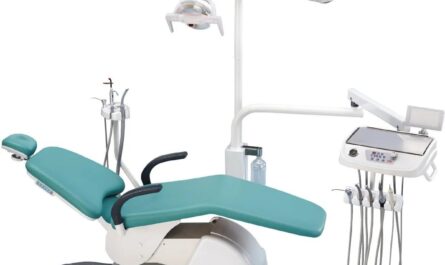Morbidity Rates of Chronic Lung Diseases
According to the World Health Organization (WHO), COPD is currently the third leading cause of death globally. In 2020 alone, over 3 million people died as a result of respiratory illnesses. While prevalence and mortality rates vary between countries, chronic lung disorders disproportionately afflict people in low- and middle-income nations due to factors like tobacco use, air pollution, and limited access to medical care.
Role of Lung Stent Industry in Disease Management
For individuals dealing with conditions that narrow the airways, lung stents can help improve breathing and relieve symptoms. Global Lung Stent Stents are small mesh tubes that are inserted via bronchi into the lungs to keep airways open. They are often used as a minimally invasive treatment for obstructing lung tumors or to maintain patency after other procedures like bronchial thermoplasty. Stents provide structural support that prevents airway collapse, allowing for improved ventilation to parts of the lung.
Depending on the location and severity of blockage, different types of stents may be selected including self-expanding metal stents (SEMS), silicone stents, or biodegradable stents. Placement is usually done as an outpatient procedure under local anesthesia and mild sedation using a thin, flexible tube (bronchoscope) passed through the mouth or nose. Stents can often enhance quality of life for patients battling severe cases of COPD, lung cancer, or other illnesses causing airway narrowing. They serve as a valuable treatment option, especially in parts of the world with limited access to complex surgeries.
Global Market Size and Growth Projections
The global market for lung stents has grown steadily in step with rising COPD and lung cancer incidence worldwide. Market research firms project continued expansion over the next 5-10 years driven by aging populations, increased tobacco consumption in developing nations, and greater diagnosis and interventional treatment of pulmonary diseases. According to a 2021 report by Global Market Insights, the lung stent market size surpassed $150 million and is poised to progress at over 6.5% annually through 2027.
Regionally, North America currently dominates the lung stent sector due to advanced healthcare infrastructure and higher integration of minimally invasive procedures. However, developing areas like Asia Pacific and Latin America are anticipated to witness the highest growth rates. This stems from growing medical capabilities in populous countries like China, India, Brazil and Mexico coupled with significant disease burdens. As economies strengthen, more patients will gain access to stents and other therapies that improve airway patency.
Supplier Activity and Product Innovation
Major global suppliers in the lung stent arena include Boston Scientific, Taewoong Medical, Cook Medical, Merit Medical Systems, and Novatech SA among others. These companies manufacture a variety of self-expanding metallic, silicone, and hybrid designs approved for different airway applications by bodies like the U.S. FDA and European CE. Suppliers continually work to enhance ease of placement and expanded product portfolios to capitalize on lung disease therapy demands worldwide.
Several novel stents featuring refinements like increased radial strength, thinner profiles, biodegradability, and drug-eluting capabilities have emerged in recent years. New drug-delivery stents aim to safely and slowly release chemotherapy directly to cancerous lung tumors. Biodegradable models fabricated from materials like PLGA breakdown naturally in the airways, avoiding future complications from non-biocompatible materials. These technological improvements coupled with expanded training and education are helping drive lung stenting utilization globally, especially in under-resourced regions.
Accessibility Challenges and Potential Solutions
While lung stents represent an important treatment option for obstructive pulmonary conditions, availability is still hampered in low and middle-income nations. High costs, lack of specialized providers, and weak medical infrastructures can impede widespread stent access. Even in developed markets, rural patients face greater geographic barriers. Creative solutions are being explored to counter these challenges and spread the benefits of airway patency technologies more equitably worldwide.
One strategy entails training local physicians in basic bronchoscopic skills and basic stent placement through educational outreach programs. Teams of international experts visit areas to teach courses and provide hands-on demonstrations. Loaner or lower-cost equipment may be supplied initially until local infrastructure improves. Multinational suppliers are exploring partnerships with nations to offer stents and accessories at reduced prices tailored for specific markets. Regional manufacturing hubs could drive down costs through economies of scale if demand becomes substantial enough.
Telemedicine also shows promise as a means to expand expertise into remote locales via virtual bronchoscopy procedures guided by international pulmonologists. While not a full substitute for in-person care, technologies like this may help fill gaps, especially in emergency situations where airways require stabilization until patients can access interventional facilities. As access widens, patients from all backgrounds stand to gain enhanced quality and length of life through safe, minimally-invasive treatments like lung stenting.
In summary, lung stents play an important supportive role in managing chronic pulmonary disorders worldwide. Although developed areas currently lead placement rates, conditions like COPD create growing global disease burdens that stent therapies can help address. Major suppliers continually advance products to refine safety and effectiveness. Despite accessibility barriers in certain low-resource regions, creative solutions involving training, cost reductions, regional manufacturing, and telemedicine show promise in disseminating lung stenting technologies more equitably. As healthcare capabilities expand in populous developing nations, the lung stent industry seems poised for continued growth in serving patients everywhere challenged by obstruction of the airways.
*Note:
1.Source: Coherent Market Insights, Public sources, Desk research
2.We have leveraged AI tools to mine information and compile it




